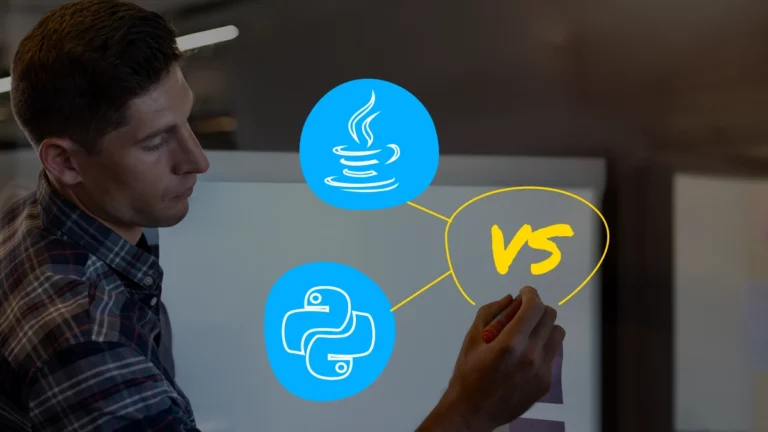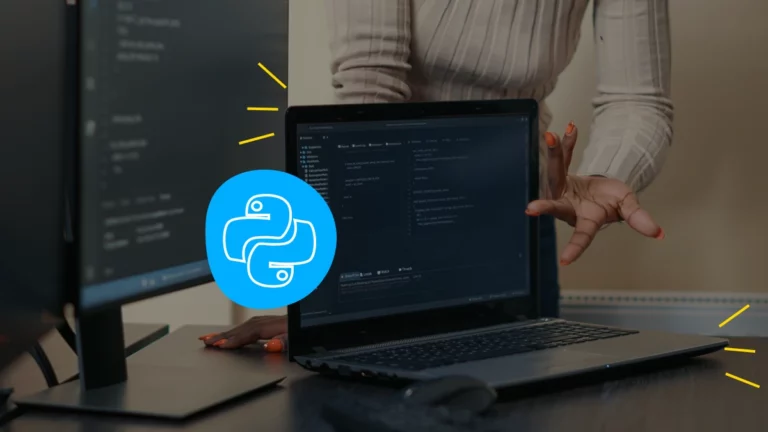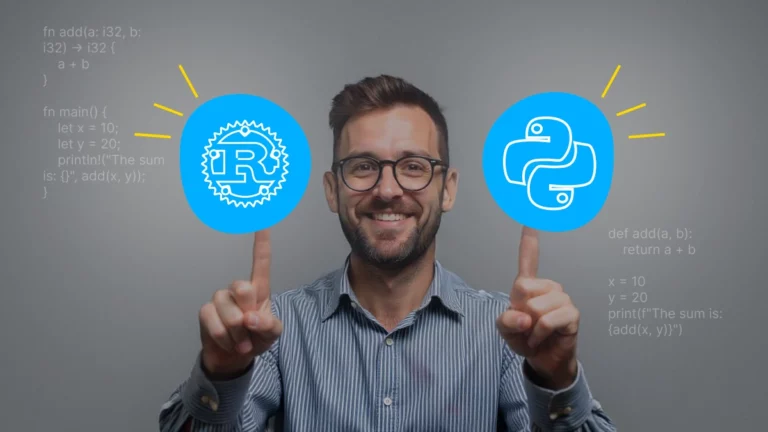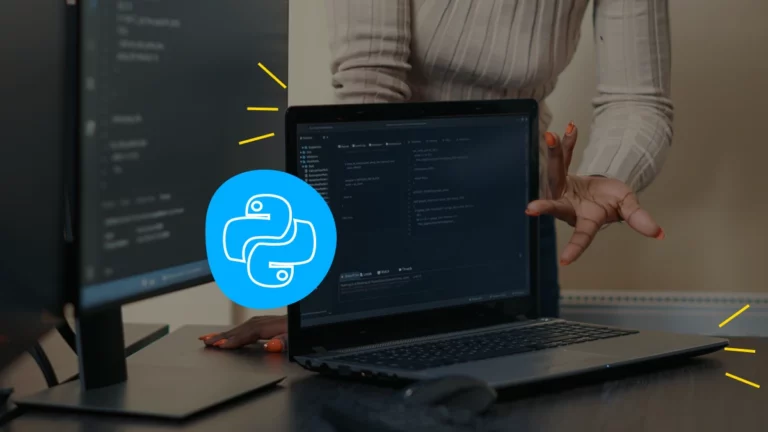PHP vs. Python: How to Choose the Right Programming Language
- The Basisc on PHP vs Python: the Technical Side of the Matter
- Real-World Application and Use Cases
- Technology Expertise with Mobilunity
- PHP and Python: Key Features to Compare
- Security as a Bearing Structure
- A Few Words on a Learning Curve
- Community Support for Technologies
- Strengths and Weaknesses of Python and PHP
- The Final Decision: When to Choose PHP and When – Python
- Instead of Conclusion: What’s Ahead?
Picture this: you bought a new car, but driven with excitement, you forgot to ask a car dealership whether it’s compatible with any fuel. At the nearest gas station, you chose whatever and paid for it. But the car doesn’t start. Reason? Exactly, the wrong fuel.
The same goes for technologies – the wrong programming language will be useless for a specific project, and it won’t move.
Today, our case is the differences between PHP and Python, two popular choices in web application development.
Both Python and PHP have taken significant niches when it comes to app development and web pages, running countless websites and web applications worldwide. Each language’s web framework defines its versatility and scalability. For instance, Python is used across a variety of domains, from backend development to data science, while PHP is primarily used for web development projects, remaining a reliable choice for server-side scripting.
For instance, statistics of PHP for websites reports that PHP continues to hold a considerable share in the programming languages market, particularly in server-side web development, being used by 75.2% of all websites whose server-side programming language is known.
At the same time, Statista indicates that Python is among the top programming languages globally, with approximately 48% of developers using Python code to build a wide range of applications.
But how do you decide which one best matches your business needs?
In this article, we’ll provide a detailed comparison of these two programming languages. We’ll explore Python vs PHP for web development use cases, discover market trends, break down key features, and describe suitable scenarios for different types of projects. Hopefully, it will guide you in making an informed decision between PHP vs. Python.
Disclaimer: This article doesn’t favor one technology over the other. It serves as a guide to help you choose the right one for your needs.
The Basisc on PHP vs Python: the Technical Side of the Matter
The Python vs PHP comparison usually starts with technical foundations. So, let’s get to know what moves these languages.
PHP
PHP, or Hypertext Preprocessor, is a server-side scripting language initially designed for web development. Over the years, it has significantly changed and developed, having gained features that improve performance and security.
Constant relevance. The technology has flawless compatibility with most common CMS platforms like WordPress and Drupal, which makes it essential for dynamic web applications.
Streamlined setup. Its integration with HTML and user-friendly deployment makes it a trustworthy choice for assembling dynamic websites.
Python
Python programming language is a high-level, general-purpose development technology famous and favored for its simplicity and readability. Its versatility along with constant updates and improvements in each new Python version has strengthened it as a first choice for handling diverse and complex programming challenges.
Multifunctionality. Its comprehensive library ecosystem helps developers work efficiently across various domains, including AI, web development, and automation.
Syntax simplicity. The language promotes code clarity and readability, making it an optimal solution for both beginners and experienced developers.
Real-World Application and Use Cases
Where does PHP or Python fit best? Let’s see some of the most widespread scenarios.
Content Management Systems (CMS)
PHP. One of the most standout features of PHP is its majority in the CMS domain. Platforms such as WordPress, Joomla, and Drupal were written in PHP. It streamlines web content management, sustains extensive plugins, and provides quick deployment for websites that need regular updates. Thanks to its CMS supremacy, PHP is an ideal option for SMEs and content-focused platforms.
Python. Businesses often rely on Python code to power CMS options like Wagtail and Django, which are built for high-customization needs and comprehensive workflows. Although Python is not so popular in the CMS domain, its tools are a perfect fit for companies that need specific content management features or integration with AI-driven personalization. It’s highly flexible to build custom CMS solutions, which boosts its competitiveness for enterprise-level projects.
Web development
PHP. Well-known for its server-side scripting, PHP is often the backbone for many CMS platforms, including WordPress and Drupal. Its web frameworks like Laravel and CodeIgniter boost development speed and flexibility for creating dynamic websites. PHP is a key component for developers building content-driven or e-commerce websites with strong server-side capabilities.
Python. While the language is less prevailing in conventional web development, developers often use Python web frameworks like Django and Flask to build secure and data-driven applications. They empower scalable, secure, and data-driven applications, highlighting Python as a pillar for complex and multi-functional web projects. Although Python is not initially a web-first language, its versatility guarantees adaptability to a large variety of web development needs.
API development
PHP. With frameworks like Slim and Lumen, PHP is used for fast and light API development process. Its ability for smooth integration with relational databases ensures its efficiency in building APIs that operate with dynamic content for web or mobile applications. It’s a perfect fit for web services with rapid deployment and low resource consumption being critical.
Python. In web app development, Python offers frameworks such as FastAPI and Flask for assembling high-performance APIs with built-in validation and asynchronous support. As Python emphasizes data-driven applications, its APIs are the go-to choice for complex workflows or integration with AI and ML systems. Python frameworks are a perfect fit for businesses seeking scalable, robust, and data-intensive API solutions.
Data Science and Machine Learning
PHP. The lack of native libraries for complex computations limits PHP for adoption in data science and ML tasks. Although the technology can manage basic data processing, it’s not powerful enough for advanced analytical workloads. PHP’s capability in this domain lags far behind those particularly designed for data-centric tasks.
Python. Thanks to its rich library ecosystem, including Pandas, NumPy, TensorFlow, and Scikit-learn tools, Python provides an irreplaceable toolset for AI, ML, and data analysis tasks. Its simplicity and wide community support significantly contribute to the rapid prototyping and deployment of complex models. Companies often use Python for projects that need advanced data manipulation, analytics, and predictive modeling.
Technology Expertise with Mobilunity
Traditionally, we’ll share a couple of stories on how we fulfill clients’ pains and needs, providing the right talents for their requirements.
Strengthening the Zenchef restaurant booking platform with PHP developers
Zenchef, a France-based online restaurant booking platform, aimed to enhance its solution. Their main challenge was finding skilled developers locally to optimize and scale their backend systems. Zenchef approached us for our Nearshoring model to address their talent needs, which would ensure high quality and cost-efficiency.
Mobilunity team managed the entire process by thoroughly understanding the client’s requirements and picking candidates with deep expertise in PHP. We completely tailored our recruitment approach to provide dedicated developers who would seamlessly integrate with Zenchef’s in-house team. This collaboration allowed Zenchef to accelerate development, improve system performance, and enhance scalability, which resulted in a long-term and still ongoing partnership. If you’re seeking expert backend developers for similar projects, don’t hesitate to hire PHP Laravel developers to ensure your development goals are met efficiently.
Building an open-source ERP with Python and Odoo developers
Camptocamp, a Swiss leader in geospatial, business, and infrastructure solutions, required experienced Python developers to support and develop their innovative platform software. The company’s challenge was finding Python experts able to handle complex and diverse project requirements while working with the Odoo framework.
Mobilunity addressed this need by delivering tailored recruitment services to provide developers with extensive Python experience and strong problem-solving skills. A structured and efficient hiring process secured the selection of candidates who aligned with Camptocamp’s technical needs and corporate culture. The new developers integrated seamlessly into Camptocamp’s workflows just like in-house team members, maintaining high-quality software delivery. This collaboration strengthened Camptocamp’s development capacity and resulted in fruitful and mutually beneficial collaboration.
PHP and Python: Key Features to Compare
Now, let’s walk through the main technical features of Python and PHP.
| Feature | PHP | Python |
| Syntax and Readability | – Traditional and verbose syntax, often embedded in HTML. – Quick for dynamic web pages but can lead to disorganized codebases in large projects. – Requires extra effort to maintain clarity. | – Clean, English-like syntax enhances readability and maintainability. – Easy for beginners and supports error-free coding for professionals. – Perfect for fast development cycles. |
| Performance and Speed | – Optimized for web apps with JIT compiler (PHP 7+). – Provides fast and reliable server-side performance. – Suitable for high-traffic websites. | – Slower runtime due to interpreted nature. – Prevails in data-heavy tasks with robust libraries. – Perfect for advanced computation needs. |
| Framework Availability | – Laravel and Symfony simplify routing, authentication, and database management. – Designed for streamlined and fast web development. | – Django and Flask cater to scalable and flexible apps. – Django suits for large projects; – Flask supports lightweight applications. |
| Integration Capabilities | – Integrates seamlessly with web servers like Apache and Nginx. – Slim and Lumen frameworks support fast API development. – Optimized for CMS-based websites. | – Strong for data-driven apps with tools like FastAPI for high-performance APIs. – Supports message queues (RabbitMQ, Kafka) for distributed systems. |
| Scalability and Flexibility | – Good scalability for small-to-medium projects. – Modern frameworks like Laravel enhance scalability for larger workloads. – Best for web-centric applications. | – Modular architecture supports distributed computing for complex systems. – Scalable across domains like AI, web apps, and data pipelines. |
| Database Support | – Excellent integration with relational databases like MySQL and PostgreSQL. – Frameworks like Laravel include ORM tools for simplified queries. | – Supports both relational (PostgreSQL, SQLite) and non-relational (MongoDB, Cassandra) databases. – Flexible for varied data storage needs. |
| Error Handling and Debugging | – Uses external tools like Xdebug for advanced debugging. – Effective but requires additional setup. – Ideal for identifying logical errors in web apps. | – Built-in tools like PDB offer real-time debugging. – Intuitive error-handling syntax (try-except) simplifies fail-safe coding for critical tasks. |
| Hosting and Deployment | – Traditional hosting providers ensure simple and cost-effective deployment. – Optimized for shared hosting environments. | – More effort required for deployment, especially non-web apps. – Tools like Docker and Kubernetes enhance scalability for complex deployments. |
Syntax and readability
PHP. Here, the syntax is more traditional, and verbose, and is often embedded directly into HTML. Although it enables developers to build dynamic web pages quickly, it can result in disorganized codebases in extensive projects. Supporting PHP code often demands extra effort to provide clarity and prevent potential errors.
Python. Since Python is recognized for its clean, English-like flow, developers obtain significantly enhanced code readability and maintainability. Therefore, the language has a reduced learning curve for beginners, empowering more professional developers to write error-free code at the same time. Python aims for simplicity and clarity, which makes it a perfect choice for fast development cycles.
Performance and speed
PHP. PHP prevails in web-based applications, especially with the performance modifications presented in PHP 7 and later. Its just-in-time (JIT) compiler upgrades execution speed, ensuring the efficiency of the language for server-side tasks. Consequently, PHP provides fast, strong, and reliable solutions for websites with high traffic and content-driven requirements.
Python. Although Python is an interpreted language that slows down its performance in web-specific tasks, it stands out in data-intensive applications with its robust and extensive libraries streamlining processing speed. So Python’s slower runtime is paid off with its versatility in scenarios with advanced computation needs.
Web framework availability
PHP. Frameworks like Laravel, Symfony, and CodeIgniter are several fast application development tools that enhance PHP’s capabilities. They simplify numerous complex tasks, including routing, authentication, and database management. The framework ecosystem is built for software engineers seeking to streamline web projects they’re working on.
Python. Django and Flask are quite efficient web development frameworks for creating scalable and data-driven applications. While Django equips developers with a comprehensive suite of tools for extensive projects, Flask ensures flexibility for lightweight applications. Both of them introduce Python’s adaptability to various scenarios.
Integration capabilities
PHP. Given its ability for smooth integration with web servers like Apache and Nginx, PHP offers a reliable technology for assembling dynamic web pages. If you take such frameworks as Slim or Lumen to build a RESTful API for a CMS-based website, they will provide lightweight and fast API development. PHP is highly compatible with traditional hosting environments meaning developers can avoid extensive configuration when deploying web apps.
Python. Python’s integration capabilities prove themselves in data-driven applications. For instance, FastAPI helps developers build high-performance APIs that back up real-time data processing for ML solutions. Also, Python’s ability to interact with such message queues as RabbitMQ or Kafka facilitates the development of distributed systems, optimizing it for enterprise-grade backend solutions.
Scalability and flexibility
PHP. Being suitable for small to medium-scale projects, PHP is less scalable without auxiliary tools. At the same time, modern frameworks like Laravel manage these challenges through advanced features for larger workloads. Due to its web-centric design, PHP is a good fit for straightforward scalability.
Python. Through its modular architecture and support for distributed computing Python also provides resilient scalable web app development for complex systems. Multiple enterprise-level projects that need scalability across domains, including web applications, AI models, and data pipelines are written in Python. The technology’s flexibility confirms its adjustment to growing project needs.
Database support
PHP. As PHP is greatly integrated with such relational databases as MySQL, PostgreSQL, and MariaDB, it’s a perfect match for web-centric ecosystems. Let’s say that when you use PHP with MySQL for an e-commerce platform, this pairing will efficiently operate customer data, product catalogs, and transaction records. Above that, frameworks like Laravel further streamline database interchanges with incorporated ORM tools like Eloquent, allowing developers to execute complex queries without raw SQL.
Python. Fortunately enough, Python supports both relational (e.g., SQLite and PostgreSQL) and non-relational (e.g., Cassandra and MongoDB) databases. For instance, when you run a big data project, you will use Python’s libraries like SQLAlchemy to manage structured data in PostgreSQL and PyMongo for unstructured data in MongoDB. This flexibility highlights Python’s relevance for projects implying various data storage needs like analytics platforms or IoT applications.
Error handling and debugging
PHP. This activity in PHP often needs external tools or frameworks for advanced debugging, such as Xdebug. For example, throughout web application development, a software engineer can use Xdebug with, say, PhpStorm IDE to follow the code and pinpoint logical errors in dynamic page rendering. Although effective, PHP’s debugging workflows may require additional setup.
Python. Regularly used in web development, Python comes with powerful built-in debugging tools such as the Python Debugger (PDB) and exception-handling mechanisms. When developers work on a data processing pipeline, they can apply PDB to pause execution, inspect variables, and recognize error propagation in real time. Due to its intuitive error-handling syntax (e.g., try-except blocks), Python simplifies fail-safe code writing, especially for applications running large datasets or critical operations.
Hosting and deployment
PHP. As PHP is backed by traditional hosting providers, its code deployment is simple and cost-effective. Multiple shared hosting services are preconfigured for PHP, cutting setup time. For web projects, PHP’s deployment process is highly optimized.
Python. Deployment with Python can take more effort, especially for non-web applications. Such tools as Docker and Kubernetes streamline this process, providing scalability and efficiency. Python’s deployment workflows are adjusted for developers on complex or large-scale projects.
Security as a Bearing Structure
A pillar, a foundation – you name it. But none of us can imagine a reliable language technology without security. So we decided to highlight this characteristic as a standalone feature.
PHP’s security peculiarities
Framework-level protections. Modern PHP frameworks like Laravel and Symfony provide advanced security features like integrated Cross-Site Request Forgery (CSRF) protection, SQL injection safeguards, and powerful input validation. These frameworks guarantee a foundational layer of security, equipping developers with best practices at the same time.
Historical vulnerabilities and improvements. Although PHP has historically faced challenges with vulnerabilities, it’s mostly related to poor coding practices rather than defects in the language itself. Throughout the years, the PHP community and developers have significantly improved language resilience, placing much more security into current applications.
Compatibility with third-party security tools. PHP’s broad application in web development guarantees compatibility with diverse security solutions (e.g. ModSecurity) and specific encryption libraries. These tools have seamless integration to strengthen application security with minimal developers’ effort.
Python’s security features
Robust libraries and frameworks. Python frameworks like Django and Flask deliver robust security out-of-the-box, including middleware for executing HTTPS, ORM-based protection against SQL injection, and an extensive authentication toolset. All of these streamline the implementation of industry-standard security approaches.
Community-driven security initiatives. Python is also actively supported by its community which constantly prioritizes secure coding methods. Regular updates and well-documented and structured guidelines provide developers with smooth and efficient vulnerability governance.
Adoption in cybersecurity tools. Python’s distinction in cybersecurity, driving tools like Metasploit and Scapy, highlights its trustworthiness. This emphasizes Python’s adaptability and its significant priority on secured application development.
A Few Words on a Learning Curve
A lot of things in software development language, including its adoption, depend on how easy it is to learn the technology. So what about these two?
PHP
HTML integration requirements. PHP is extremely connected with web development, often encouraging developers to grasp the fundamentals of HTML and CSS. Although this relation works for PHP, making it a perfect match for web-based projects, it can be not as easy to learn as compared to Python, which complicates the learning path for those without previous web development experience. This also enables a joint focus on both frontend and backend skills.
Web-centric emphasis. Developers curious about creating dynamic websites can leverage a straightforward path into server-side scripting. PHP’s ability to integrate with HTML streamlines the process of embedding server-side logic into web pages, turning it into a suitable option for web developers. This priority creates an appealing entry point for those prone to web technologies.
Traditional syntax challenges. Although powerful, PHP’s syntax is less intuitive than Python’s. For newcomers from simpler programming languages, it might be difficult to follow PHP’s more traditional structure. Yet, practice opens up its operability, especially for web-centric projects.
Python
Beginner-friendly syntax. Python uses its intuitive and readable flow and natural English language resemblance to reduce the learning curve for beginners, making it an accessible option for developers. This clarity highly encourages them, reducing typical errors and allowing them to focus on problem-solving instead of syntax. It’s often the first language that future developers learn in programming courses because of its accessibility.
Extensive resources. Python benefits from an active community and generative learning resources, including extensive documentation, video tutorials, and interactive platforms (Codecademy, LeetCode, etc). These resources are aimed at all-rank developers, simplifying their knowledge advancement and the transition into practical coding projects.
Versatility across domains. One of Python’s key advantages is its versatility, allowing developers to discover multiple domains without studying a new language. This characteristic expands developers’ possibilities and allows them to implement their skills across various industries.
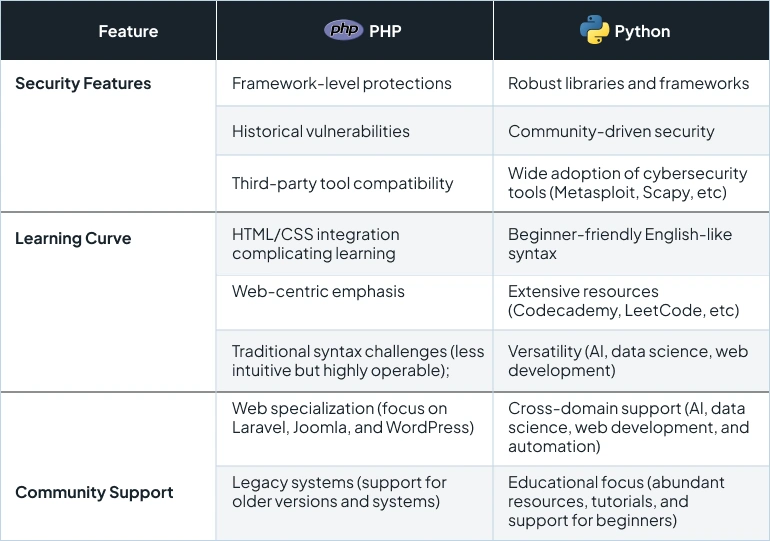
Community Support for Technologies
Every technology only exists and gets stronger because of its adopters, developers, and the community they all build around it. PHP and Python are no exception. So what do these languages get from their advocates?
PHP
Web development specialization. PHP’s community mainly emphasizes web development, with strong knowledge of such frameworks as Laravel, Joomla, and WordPress. This domain confirms that software engineers can find targeted solutions for widespread web-related issues, making PHP a trustworthy option for dynamic web applications.
Legacy and backward compatibility. PHP has a wide range of legacy-driven resources and forums. The language’s long-lasting presence in the programming area has nurtured a community skilled enough to support and enhance such systems. This adherence to backward compatibility provides constant support for previous PHP versions and systems, setting it as a reliable choice for projects that demand constant maintenance.
Python
Strong cross-domain support. The language community is exceptionally diverse, covering fields like AI, data science, web development, and automation. Programmers leverage multiple libraries and specifically customized resources, contributing to innovation and collective problem-solving. This diversity confirms the versatility of Python as a tool for a large variety of applications.
Educational and beginner focus. Python’s community remarkably highlights education for developers, suggesting comprehensive tutorials, beginner-friendly panels, and interactive platforms. Such resources as Stack Overflow and the original documentation from Python.org are highly valuable for programmers of all experience levels, nurturing an environment that promotes constant learning and growth.
Strengths and Weaknesses of Python and PHP
Now, we are approaching one of the most interesting and important parts – comparing Python vs PHP upsides and drawbacks.
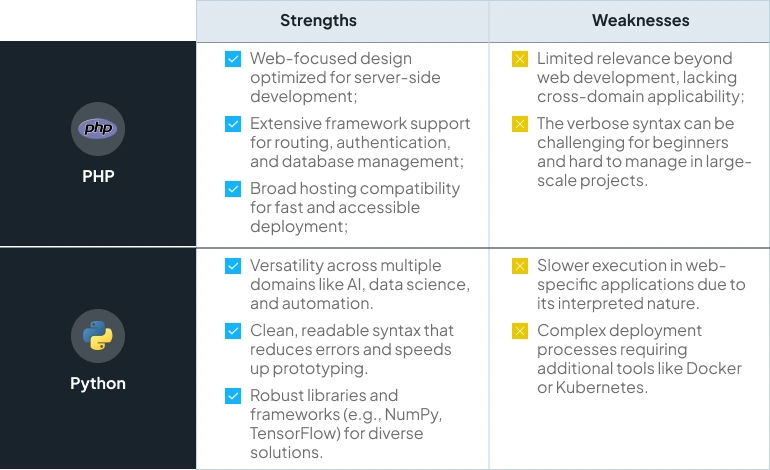
Strengths of PHP
Web-focused design. As PHP is specifically optimized for server-side web development, it delivers flawless integration with HTML and CMS platforms. This centricity comes at hand for programmers aimed at dynamic web applications.
Extensive framework support. Frameworks like Laravel and Symfony streamline complex development tasks, providing instruments for routing, authentication, and database management. These features ensure that even large-scale projects stay operable and scalable.
Broad hosting compatibility: PHP’s overall support across hosting providers highly contributes to its accessibility. Programmers can deploy applications fast avoiding any extra configurations.
Weaknesses of PHP
Limited relevance beyond web development. As PHP focuses on server-side scripting, it has limited usability in fields like data science or AI. This constraint reduces the technology’s suitability to developers searching for cross-domain options.
Verbose syntax. With all its functionality, the syntax here becomes one of the cons of PHP because of its verbosity, especially for beginners. Large-scale projects often need extra effort to keep up clarity and scalability.
Strengths of Python
Versatility. Python wins its diversity over other languages across multiple domains, including data science, AI, and automation. This cross-domain relevance makes it a favored choice for tasks requiring a blend of flexibility and scalability.
Clean and readable syntax. Python’s English-like syntax reduces development errors and encourages collaboration, particularly in teams with mixed expertise levels. Its priority with readability facilitates rapid prototyping and faster iterations.
Robust libraries and frameworks. Python’s ecosystem tools like NumPy and TensorFlow simplify even technologically-specific tasks. Programmers can create diverse solutions including scalable web applications to neural networks effortlessly.
Weaknesses of Python
Slower execution in web-specific applications. Python’s interpreted nature slows down execution speed specifically in web-focused tasks. So, applications that need real-time performance can face challenges because of this peculiarity.
Complex deployment. Python-driven applications often need further configurations or tools like Docker or Kubernetes for deployment, overcomplicating the process, which might become one of the cons of Python for web-first projects.
The Final Decision: When to Choose PHP and When – Python
As we already know, every technology is good for its purpose and fuels particular applications and environments better than others. So, through this comparison of PHP vs Python, it becomes evident that the choice depends on project requirements and future usage scenarios.
When to choose PHP
CMS-driven projects. PHP is a perfect match for projects focused on content management systems like WordPress, Joomla, or Drupal. The technology promotes rapid development and cost-efficient deployment of e-commerce platforms, blogs, e-commerce platforms, and SMB websites.
Server-side scripting. The language dominates in environments that need server-side scripting and flawless integration with relational databases like MySQL. This aspect highlights its suitability for web applications requiring dynamic content generation and database connectivity.
Traditional shared hosting. Since most providers pre-configure PHP environments, PHP is a trustworthy choice for projects deployed on shared hosting platforms. This compatibility diminishes setup complexity and guarantees swift deployment for budget-savvy teams
When to choose Python
Data-driven applications. Python is better when it comes to applications containing advanced data manipulation like AI/ML models, analytics dashboards, and big data processing. Its comprehensive libraries like Pandas and TensorFlow streamline these intricate tasks.
Scalable and multi-domain applications. Developers mostly choose Python for projects that demand scalability and flexibility like combining web development with backend data processing. Its modular design upholds distributed computing and advanced computational requirements if compared to PHP.
Automation tasks. Python’s simplicity and powerful library ecosystem make it a perfect match for automation tasks across diverse domains. This choice feels especially reasonable for Python programs combining web automation with cross-domain functionalities like ML tasks.
When to use both together
Web development with advanced backend processing. Both PHP and Python create reasonably the best web experiences. A PHP-based website or CMS (e.g., WordPress) can benefit from Python for advanced data processing tasks like ML algorithms or AI-driven personalization, while PHP handles front-end and server-side scripting parts.
API-driven architectures. When you pick up PHP for its fast and lightweight web services and Python – for its data-intensive API endpoints, you get reliable and resource-efficient application functionality with advanced computational capabilities. For instance, Slim or Lumen can run PHP’s quick response APIs, while Python’s FastAPI handles more complex data tasks.
Hybrid application development. A PHP-driven web application can integrate Python for specific functionalities including task automation, real-time analytics, and predictive modeling. This blend is a perfect decision for enriching existing systems without significant restructuring.
Instead of Conclusion: What’s Ahead?
As we’ve already noticed in our debate on PHP or Python, both technologies are mature and reliable programming languages for web development. They keep evolving, proving themselves, and adapting to particular niches. While PHP development prevails in content-focused web applications, the versatility of Python for web development ensures its recognition for building scalable, secure, and data-driven solutions across different domains, including AI, ML, and automation.
Meanwhile, businesses should foresee or at least understand emerging technology trends and future perspectives as it will help them plan their strategies and guide informed decisions.
So, what should we expect from these two?
PHP will integrate more extensively with modern web technologies. PHP is expected to develop further by extending support for APIs and serverless architectures. These improvements will ensure PHP’s suitability for creating versatile, modern web applications while adjusting to growing development needs.
Python will further advance its automation capabilities. The language’s simplicity and rich frameworks will promote it for diverse automation tasks across industries like IT operations, manufacturing, and finance. Python’s adaptability ensures companies can facilitate redundant tasks and easily design scalable automation solutions.
Shared advanced security and performance. Both PHP and Python will focus on security and performance updates. This priority will match the growing demand for reliable and scalable applications across various domains, highlighting the competitiveness and relevance of both languages.
If you’re still hesitating about Python or PHP, Mobilunity will always address your needs and provide the necessary expertise. Contact us today!

